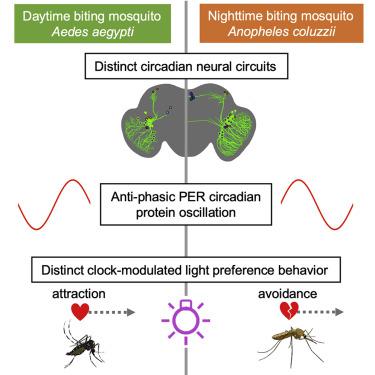Current Biology ( IF 9.2 ) Pub Date : 2020-07-02 , DOI: 10.1016/j.cub.2020.06.010 Lisa S Baik 1 , Ceazar Nave 1 , David D Au 1 , Tom Guda 2 , Joshua A Chevez 1 , Anandasankar Ray 2 , Todd C Holmes 1

|
Mosquitoes pose widespread threats to humans and other animals as disease vectors [1]. Day- versus night-biting mosquitoes occupy distinct time-of-day niches [2, 3]. Here, we explore day- versus night-biting female and male mosquitoes’ innate temporal attraction/avoidance behavioral responses to light and their regulation by circadian circuit and molecular mechanisms. Day-biting mosquitoes Aedes aegypti, particularly females, are attracted to light during the day regardless of spectra. In contrast, night-biting mosquitoes, Anopheles coluzzii, specifically avoid ultraviolet (UV) and blue light during the day. Behavioral attraction to/avoidance of light in both species change with time of day and show distinct sex and circadian neural circuit differences. Males of both diurnal and nocturnal mosquito species show reduced UV light avoidance in anticipation of evening onset relative to females. The circadian neural circuits of diurnal/day- and nocturnal/night-biting mosquitoes based on PERIOD (PER) and pigment-dispersing factor (PDF) expression show similar but distinct circuit organizations between species. The basis of diurnal versus nocturnal behaviors is driven by molecular clock timing, which cycles in anti-phase between day- versus night-biting mosquitoes. Observed differences at the neural circuit and protein levels provide insight into the fundamental basis underlying diurnality versus nocturnality. Molecular disruption of the circadian clock severely interferes with light-evoked attraction/avoidance behaviors in mosquitoes. In summary, attraction/avoidance behaviors show marked differences between day- versus night-biting mosquitoes, but both classes of mosquitoes are circadian and light regulated, which may be applied toward species-specific control of harmful mosquitoes.
中文翻译:

白天与夜间叮咬蚊子的光诱发吸引和回避行为的昼夜节律调节。
蚊子作为疾病媒介对人类和其他动物构成广泛威胁[1]。白天和夜间咬人的蚊子占据不同的昼夜生态位 [2, 3]。在这里,我们探索了白天和夜间咬人的雌性和雄性蚊子对光的先天时间吸引/回避行为反应及其通过昼夜节律回路和分子机制的调节。白天咬人的埃及伊蚊,尤其是雌性蚊子,无论光谱如何,白天都会被光吸引。相比之下,夜咬蚊子Anopheles coluzzii,特别是白天避免紫外线(UV)和蓝光。两个物种对光的吸引/回避行为随着一天中的时间而变化,并显示出明显的性别和昼夜节律神经回路差异。与雌性相比,白天和夜间活动的蚊子物种的雄性在预期晚上发病时表现出减少的紫外线回避。基于 PERIOD (PER) 和色素分散因子 (PDF) 表达的昼夜/白天和夜间/夜间叮咬蚊子的昼夜节律神经回路显示出物种之间相似但不同的回路组织。昼夜行为的基础是由分子钟计时驱动的,它在白天和夜间叮咬蚊子之间反相循环。在神经回路和蛋白质水平上观察到的差异提供了对昼夜性与夜间性的基本基础的深入了解。生物钟的分子破坏严重干扰了蚊子的光诱发吸引/回避行为。总之,吸引/回避行为显示出白天和夜间咬人的蚊子之间的显着差异,但这两类蚊子都是昼夜节律和光调节的,这可能适用于对有害蚊子的特定物种控制。


























 京公网安备 11010802027423号
京公网安备 11010802027423号